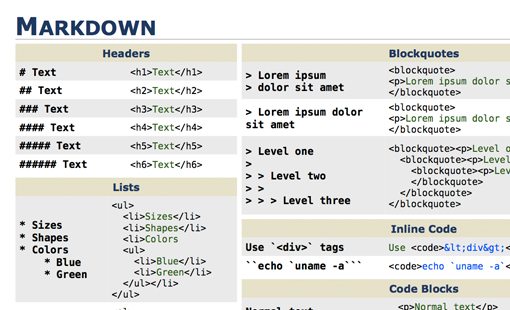Overview
Extended Syntax With the evolution of Markdown, other elements were implemented, enriching the range of options for formatting documents. On the one hand, a little more complexity, but on the other, the language gained more resources for the construction of different documents. Markdown – Graphics(Image) 2. Use brackets! for the alt text, besides that mention the image name inside the parentheses. To add the hoover text, besides the image name, add the hoover text in double-quotes. The code below shows the syntax and then the rendered output: Markdown – Graphics(Image) The rendered output is, Markdown. Note: The instructions from this guide are referring to the Classic Editor. If you are using the WordPress block editor, please see this guide. See the Markdown page for instructions on enabling Markdown for posts, pages and comments on your blog, and for more detailed information about using Markdown. Get Started Cheat Sheet Basic Syntax Extended Syntax Tools Book. The Markdown Guide. Learn Markdown in 60 pages. The Markdown Guide book includes everything you need to get started and master Markdown syntax. ️ Professional quality PDF, MOBI, and EPUB files (DRM-free) ️ Unlimited free lifetime updates.
Need to refresh your memory regarding Markdown syntax? Excellent!
Below are listed the most common and used elements of the language.

It is worth mentioning that, here only the basics of Markdown are presented, if you need more information see the basic syntax and extended syntax sections.
Basic syntax
The elements that underlie Markdown are shown below. These formatting elements were described in the original language document and the vast majority of programs support them.
| Element | Markdown |
|---|---|
| Titles | |
| Bold | |
| Italic | |
| Blockquote | |
| Ordered list | |
| Unordered list | |
| Code | |
| Horizontal rule | |
| Link | |
| Image |

Extended Syntax
With the evolution of Markdown, other elements were implemented, enriching the range of options for formatting documents. On the one hand, a little more complexity, but on the other, the language gained more resources for the construction of different documents.
Keep in mind that not all applications developed for Markdown support these elements, it is always a good idea to consult the program documentation or the tools section.
| Element | Markdown |
|---|---|
| Table | |
| Fenced code block | |
| Footnote | |
| title ID | |
| Definition list | |
| Strikethrough | |
| Task List |
Markdown
Markdown Syntax Documentation
Paragraphs
Separate paragraphs with a blank line.
Start each heading with one or more hashes, followed by a space.
*— ItalicWrap the words in single asterisks.
Wrap the words in double asterisks.
-— Unordered listStart each line with a dash and a space.
Indent before the dash for nested lists.
Start each line with a number, period & space.
Indent before the number for nested lists.
[]()— Link[]— link text inside square brackets.()— link URL inside round brackets.
Start with an exclamation point.
[]— alt text inside square brackets.()— image URL inside round brackets.
---— Horizontal ruleThree consecutive dashes on a single line.
Surround code inside other text with single backticks.
```— Code blockStart a line with three backticks to make a code block.
End the code block with three more backticks on their own line.
Optionally specify the code language after the opening backticks.
Non standard. Start a list and used square brackets with a space to denote a task.
Put an “x” between the square brackets to mark it as complete.
Github Markdown Guide
YAML
Always indent with two spaces.
Markdown Syntax Cheatsheet
Start with a term, no spaces, followed by a colon and a space.
Indent to create nested objects.
- value— ArraysStart with a dash, and a space.
Arrays inside objects:
Objects inside arrays.
Surround text with quotes (double or single) to escape text.
In all the previous examples the quotes aren’t really necessary. But I find myself almost always adding them for clarity and to prevent myself from having to think about whether I need to escape the or not.
>— Folded text blockStart with a greater than, and indent the next lines.
The text will be collapsed into a single line when parsed.
Start with a vertical pipe, and indent the next lines.
The text will keep its multiple lines when parsed.
---— Front matterYAML can be used at the top of Markdown documents to add more structured data.
Surround the YAML with two lines of consecutive dashes.
